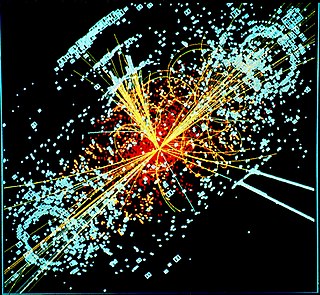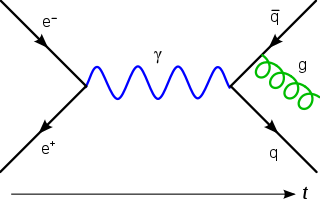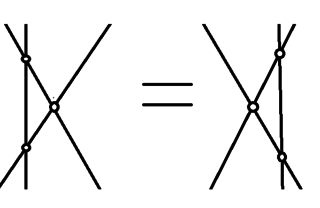
In physics, Kaluza–Klein theory is a classical unified field theory of gravitation and electromagnetism built around the idea of a fifth dimension beyond the common 4D of space and time and considered an important precursor to string theory. In their setup, the vacuum has the usual 3 dimensions of space and one dimension of time but with another microscopic extra spatial dimension in the shape of a tiny circle. Gunnar Nordström had an earlier, similar idea. But in that case, a fifth component was added to the electromagnetic vector potential, representing the Newtonian gravitational potential, and writing the Maxwell equations in five dimensions.

An instanton is a notion appearing in theoretical and mathematical physics. An instanton is a classical solution to equations of motion with a finite, non-zero action, either in quantum mechanics or in quantum field theory. More precisely, it is a solution to the equations of motion of the classical field theory on a Euclidean spacetime.

In mathematics, the braid group on n strands, also known as the Artin braid group, is the group whose elements are equivalence classes of n-braids, and whose group operation is composition of braids. Example applications of braid groups include knot theory, where any knot may be represented as the closure of certain braids ; in mathematical physics where Artin's canonical presentation of the braid group corresponds to the Yang–Baxter equation ; and in monodromy invariants of algebraic geometry.

In physics, specifically relativistic quantum mechanics (RQM) and its applications to particle physics, relativistic wave equations predict the behavior of particles at high energies and velocities comparable to the speed of light. In the context of quantum field theory (QFT), the equations determine the dynamics of quantum fields. The solutions to the equations, universally denoted as ψ or Ψ, are referred to as "wave functions" in the context of RQM, and "fields" in the context of QFT. The equations themselves are called "wave equations" or "field equations", because they have the mathematical form of a wave equation or are generated from a Lagrangian density and the field-theoretic Euler–Lagrange equations.
In the mathematical field of knot theory, the Jones polynomial is a knot polynomial discovered by Vaughan Jones in 1984. Specifically, it is an invariant of an oriented knot or link which assigns to each oriented knot or link a Laurent polynomial in the variable with integer coefficients.
In mathematics, a commutativity constraint on a monoidal category is a choice of isomorphism for each pair of objects A and B which form a "natural family." In particular, to have a commutativity constraint, one must have for all pairs of objects .
In mathematics, Tannaka–Krein duality theory concerns the interaction of a compact topological group and its category of linear representations. It is a natural extension of Pontryagin duality, between compact and discrete commutative topological groups, to groups that are compact but noncommutative. The theory is named after Tadao Tannaka and Mark Grigorievich Krein. In contrast to the case of commutative groups considered by Lev Pontryagin, the notion dual to a noncommutative compact group is not a group, but a category of representations Π(G) with some additional structure, formed by the finite-dimensional representations of G.

In physics, the Yang–Baxter equation is a consistency equation which was first introduced in the field of statistical mechanics. It depends on the idea that in some scattering situations, particles may preserve their momentum while changing their quantum internal states. It states that a matrix , acting on two out of three objects, satisfies
In mathematics, a Hopf algebra, H, is quasitriangular if there exists an invertible element, R, of such that

A topological quantum computer is a theoretical type of quantum computer proposed by Russian-American physicist Alexei Kitaev in 1997. It utilizes quasiparticles, known as anyons, in two-dimensional systems. These anyons' world lines intertwine to form braids in a three-dimensional spacetime. These braids act as the logic gates of the computer. The primary advantage of using quantum braids over trapped quantum particles is enhanced stability. While small, cumulative perturbations can cause quantum states to decohere and introduce errors in traditional quantum computations, such perturbations do not alter the topological properties of the braids. This stability is akin to the difference between cutting and reattaching a string to form a different braid versus a ball colliding with a wall.
In mathematics, a metric connection is a connection in a vector bundle E equipped with a bundle metric; that is, a metric for which the inner product of any two vectors will remain the same when those vectors are parallel transported along any curve. This is equivalent to:

A vertex model is a type of statistical mechanics model in which the Boltzmann weights are associated with a vertex in the model. This contrasts with a nearest-neighbour model, such as the Ising model, in which the energy, and thus the Boltzmann weight of a statistical microstate is attributed to the bonds connecting two neighbouring particles. The energy associated with a vertex in the lattice of particles is thus dependent on the state of the bonds which connect it to adjacent vertices. It turns out that every solution of the Yang–Baxter equation with spectral parameters in a tensor product of vector spaces yields an exactly-solvable vertex model.
In mathematical physics the Knizhnik–Zamolodchikov equations, or KZ equations, are linear differential equations satisfied by the correlation functions of two-dimensional conformal field theories associated with an affine Lie algebra at a fixed level. They form a system of complex partial differential equations with regular singular points satisfied by the N-point functions of affine primary fields and can be derived using either the formalism of Lie algebras or that of vertex algebras.
Quantum characteristics are phase-space trajectories that arise in the phase space formulation of quantum mechanics through the Wigner transform of Heisenberg operators of canonical coordinates and momenta. These trajectories obey the Hamilton equations in quantum form and play the role of characteristics in terms of which time-dependent Weyl's symbols of quantum operators can be expressed. In the classical limit, quantum characteristics reduce to classical trajectories. The knowledge of quantum characteristics is equivalent to the knowledge of quantum dynamics.
In mathematics, a braided vector space is a vector space together with an additional structure map symbolizing interchanging of two vector tensor copies:

In physics and mathematics, and especially differential geometry and gauge theory, the Yang–Mills equations are a system of partial differential equations for a connection on a vector bundle or principal bundle. They arise in physics as the Euler–Lagrange equations of the Yang–Mills action functional. They have also found significant use in mathematics.

Attempts have been made to describe gauge theories in terms of extended objects such as Wilson loops and holonomies. The loop representation is a quantum hamiltonian representation of gauge theories in terms of loops. The aim of the loop representation in the context of Yang–Mills theories is to avoid the redundancy introduced by Gauss gauge symmetries allowing to work directly in the space of physical states. The idea is well known in the context of lattice Yang–Mills theory. Attempts to explore the continuous loop representation was made by Gambini and Trias for canonical Yang–Mills theory, however there were difficulties as they represented singular objects. As we shall see the loop formalism goes far beyond a simple gauge invariant description, in fact it is the natural geometrical framework to treat gauge theories and quantum gravity in terms of their fundamental physical excitations.
A two-dimensional conformal field theory is a quantum field theory on a Euclidean two-dimensional space, that is invariant under local conformal transformations.
In mathematics, and especially differential geometry and mathematical physics, gauge theory is the general study of connections on vector bundles, principal bundles, and fibre bundles. Gauge theory in mathematics should not be confused with the closely related concept of a gauge theory in physics, which is a field theory that admits gauge symmetry. In mathematics theory means a mathematical theory, encapsulating the general study of a collection of concepts or phenomena, whereas in the physical sense a gauge theory is a mathematical model of some natural phenomenon.
Tau functions are an important ingredient in the modern mathematical theory of integrable systems, and have numerous applications in a variety of other domains. They were originally introduced by Ryogo Hirota in his direct method approach to soliton equations, based on expressing them in an equivalent bilinear form.





















